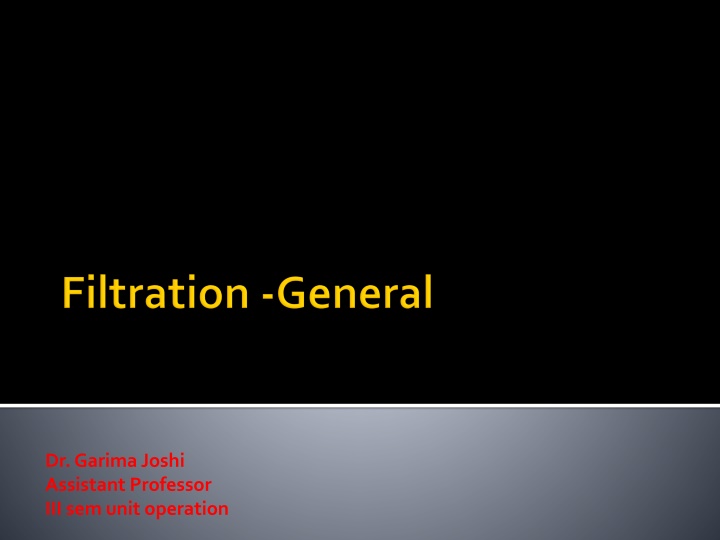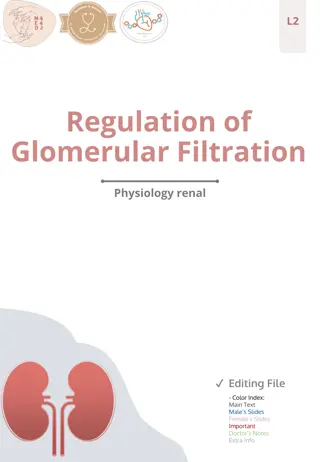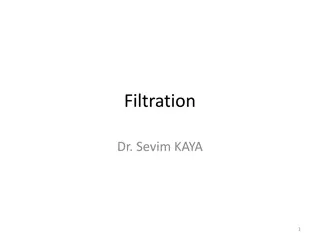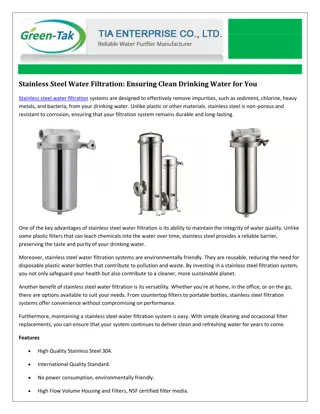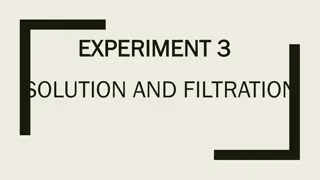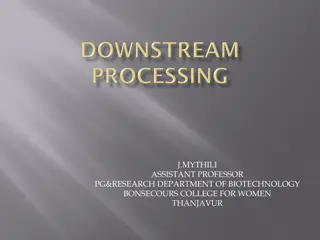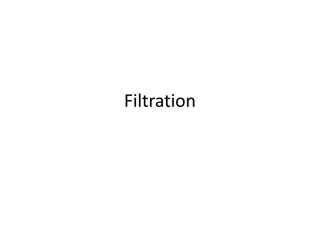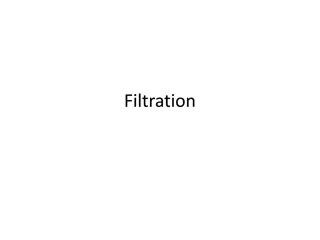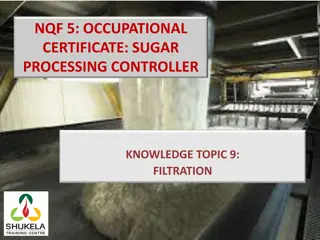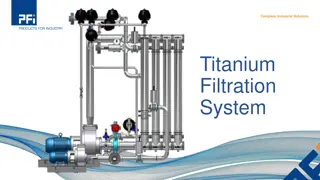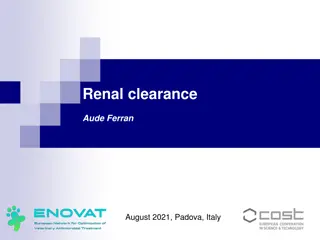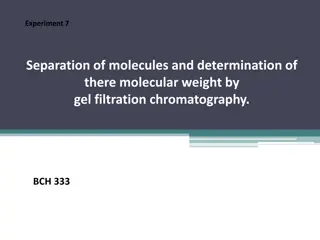Factors Affecting Filtration Rate & Methods to Increase Rate
Rate of filtration is crucial in various processes, influenced by factors like particle properties, shape, size distribution, and more. Darcy's law plays a significant role in monitoring filtration. Understanding the impact of surface area, filter bed, and medium is key to managing filtration rates effectively. Various methods such as using large filters or connecting small units in parallel can enhance the filtration rate. Moreover, the pressure drop, viscosity of fluid, and characteristics of the filter medium all play critical roles in determining the efficiency of filtration processes.
Download Presentation

Please find below an Image/Link to download the presentation.
The content on the website is provided AS IS for your information and personal use only. It may not be sold, licensed, or shared on other websites without obtaining consent from the author.If you encounter any issues during the download, it is possible that the publisher has removed the file from their server.
You are allowed to download the files provided on this website for personal or commercial use, subject to the condition that they are used lawfully. All files are the property of their respective owners.
The content on the website is provided AS IS for your information and personal use only. It may not be sold, licensed, or shared on other websites without obtaining consent from the author.
E N D
Presentation Transcript
Dr. GarimaJoshi Assistant Professor III semunit operation
Rate of filtration is affected by various factors. It is mainly monitored by Darcy s law. Properties of solid Particle shape Particle size Particle charge Density Particle size distribution Rigidity or compressibility of solid under pressure Tendency of particle to flocculate or adhere together
Rate of Filtration is Inversely proportional to specific surface of filter bed (According to K-C equation) Directly proportional to surface area of filter medium (According to Darcy s equation). Rate can be increased either using large filter or connecting a number of small units in parallel. Filter press works on principle of connecting units in parallel
According to Darcys law the rate of filtration is proportional to the overall pressure drop across both the filter medium and filter cake. The pressure drop can be achieved in a number of ways: Gravity- A pressure difference could be obtained by maintaining a head of slurry above the filter medium. The pressure developed will depend on the density of the slurry Vacuum (Reducing pressure)-The pressure below the filter medium may be reduced below atmospheric pressure by connecting the filtrate receiver to a vacuum pump and creating a pressure difference across the filter. Pressure-The simplest method being to pump the slurry into the filter under pressure. Centrifugal force- The gravitational force could be replaced by centrifugal force in particle separation
According to Darcys law rate of filtration is inversely proportional to the viscosity of the fluid. Reason behind this is an increase in the viscosity of the filtrate will increase the resistance of flow. This problem can be overcome by two methods: The rate of filtration may be increased by raising the temperature of the liquid, which lowers its viscosity. However, it is not practicable if thermolabilematerials are involved or if the filtrate is volatile. Dilution is another alternative but the rate must be doubled.
The surface upon which solids are deposited in a filter is called the Filter medium Properties of ideal filter medium: It should-be capable of delivering a clear filtrate at a suitable production rate. have sufficient mechanical strength be inert. retain the solids without plugging at the start of filtration. Not absorb dissolve material. Sterile filtration imposes a special requirement since the pore size must not exceed the dimension of bacteria or spores.
Woven material-Made up of wool, silk, metal or synthetic fibres (rayon, nylon etc.). These include a- wire screening and b- fabrics of cotton, wool, nylon. Wire screening e.g. stainless steel is durable, resistance to plugging and easily cleaned. Cotton is a common filter ,however, Nylon is superior for pharmaceutical use, since it is unaffected by mold, fungus or bacteria and has negligible absorption properties . The choice of fibredepends on chemical.
Perforated sheet metal-Stainless steel plates have pores which act as channels as in case of meta filters. Bed of granular solid built up on supporting medium-In some processes, a bed of graded solids may be formed to reduce resistance of flow-Ex. Of granular solids are gravel, sand, asbestos, paper pulp and keiselgur. Choice of solids depends on size of solids in process.
Prefabricated porous solid units- Used for its convenience and effectiveness. Sintered glass, sintered metal, earthenware and porous plastics are used for fabrication. Membrane filter media-These are cartridge units and are economical and available in pore size of 100 m to even less than 0.2 m. Can be either surface cartridges or depth type cartridges. Surface cartridges-These are corrugated and resin treated papers and used in hydraulic lines. Ceramic cartridges and porcelain filter candles are examples. Can be reuse after cleaning. Depth type cartridges: Made up of cotton, asbestos or cellulose. These are disposable items, since cleaning is not feasible.
The objective of filter aid is to prevent the medium from becoming blocked and to form an open, porous cake, hence, reducing the resistance to flow of the filtrate. Filter aid forms a surface deposit which screens out the solids and also prevents the plugging of supporting filter medium. Characteristics of filter aids: Chemically inert and free from impurities. Low specific gravity, so remain suspended in liquids. Porous rather than dense, so that pervious cake can be formed. Disadvantages: Remove the coloured substances by absorbing them. Sometimes active principles such as alkaloids are absorbed on filter aid. Rarely, filters are source of contamination such as soluble iron salts, which can provoke degradation of sensitive ingredient.
Filter aids may be used in either or both two ways: 1) Pre- coating technique: by forming a pre-coat over the filter medium by filtering a suspension of the filter aid . 2) Body-mix technique: A small proportion of the filter aid (0.1-0.5 %) is added to the slurry to be filtered. This slurry is recirculated through the filter until a clear filtrate is obtained, filtration then proceeds to completion. Different flow rates can be achieved depending on grade ofaid- 1. Low flow rate: fine grade filter aids- mainly used for clarity 2. Fast flow rate: coarse grade filter aids- acceptable filtrate. Examples of filter aids Diatomite (Keiselgur) , obtained from natural siliceous deposits. Perlite , it is an aluminium silicate. Cellulose, Asbestos,charcoal, talc, bentonite
